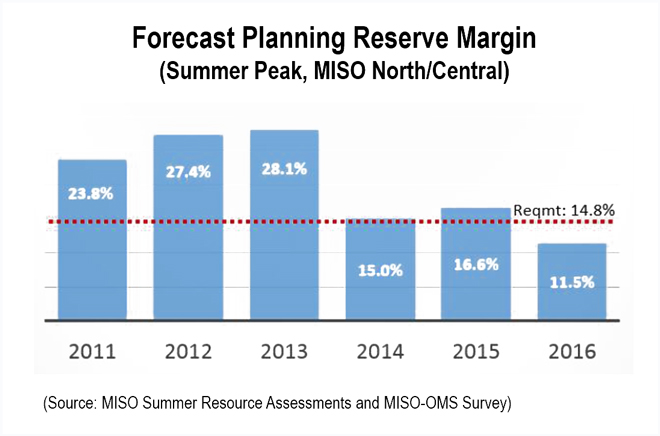By Rich Heidorn Jr.

MISO currently assesses resource adequacy annually, based on meeting the summer peak. But in a “hot topic” discussion at last week’s Advisory Committee meeting, all sectors except the Power Marketers and Independent Power Producers indicated support in adopting, or at least studying, a change to allow seasonal products.
“Under the current annual construct, seasonal demand is unaccounted for, seasonal resource capability and availability (most notably gas) is not recognized and seasonal transmission differences are not taken into consideration,” Manitoba Hydro, representing the Coordinating Sector, said in its written comments.
Flexibility
“An annual construct may result in reliance on resources when they are unlikely to be available and may underestimate the risk of loss of load other than at summer peak,” the company continued. “In addition, lack of flexibility for load to procure capacity (or be forced to over-procure for all months of the year) to meet variable seasonal demand is simply less efficient and cost effective.”
The company called not for a summer-winter construct but one that used four seasons, which it said would align with commercial contracts, financial transmission rights auctions and quarterly data submittals to the North American Electric Reliability Corp.
Steve Dahlke of the Great Plains Institute, representing the Environmental sector, said a seasonal construct would add more “granularity,” capturing, for example, wind’s increased production in the winter.
“We’ve seen wind resources helping out during this winter’s events,” he said, noting that wind generation set an all-time record Jan. 8, the peak demand day for the RTO this winter. He said it would also capture demand response not available in the summer.
The Transmission Dependent Utilities said a seasonal construct is “the most significant improvement” MISO could make to improve resource adequacy and urged MISO to implement it as soon as the 2016/17 planning year.
“The concept of a seasonal construct has been raised in a number of different forums over the past few years; however, MISO’s commitment to explore and pursue a seasonal construct still remains unclear,” it said. “… Stakeholders in the Supply Adequacy Working Group (SAWG) are still waiting for MISO’s views on this topic after formal discussions related to a seasonal construct began in early 2014.”
No Immediate Help
The IPP sector, however, said that such a change would not help MISO address expected capacity shortages in MISO North and Central next year. It noted that MISO has indicated a transition to a seasonal product could not happen before the 2017/18 planning year.
The IPPs said they were reserving judgment on the concept and that no discussion should occur until MISO publishes a promised white paper examining potential risks and opportunities.
“The IPP sector remains concerned that MISO has already pre-committed publically to state regulators to moving to a seasonal resource adequacy construct and without a fully vetted stakeholder process,” it said. “Such a process could prove lengthy, as already demonstrated when the current resource adequacy construct evolved from a monthly to an annual process. The MISO stakeholder process and regulatory process at [the Federal Energy Regulatory Commission] took almost four years before changes were accepted.”
“I don’t think it’s a forgone conclusion that we should move to a seasonal construct,” Dynegy’s Mark Volpe, representing the IPPs, told the committee.
The Power Marketers, meanwhile, said the idea was a solution in search of a problem. “Resource adequacy must be achieved every day, so having less capacity committed to the footprint on any given day will only serve to reduce reliability,” they said. “Subsequently, the economic efficiency of the energy market will suffer by reducing the number of resources that are available to be committed on a day-ahead and real-time basis.”
Opposition to Mandatory Capacity Market
There was almost as much consensus among stakeholders in opposition to a move to a mandatory capacity market such as PJM’s.
“MISO is not PJM,” said Justin Joiner of Vectren. “The concerns there do not exist in MISO.”
Alcoa and other members of the End-Use Customers sector also rejected the idea, also noting the differences between MISO, PJM, NYISO and ISO-NE.
“There has been a vibrant bilateral capacity market in place within the MISO footprint that has allowed end-use customers in MISO that do have retail choice (as well as municipal and cooperative electric utilities) the ability to contract for capacity at fixed prices at least three years into the future at reasonable prices significantly lower than in these other ISOs and RTOs,” it said.
The Organization of MISO States said it opposed imposition of a downward sloping demand curve or a minimum offer price rule, or the elimination of fixed resource adequacy plans.
No ‘Missing Money’ Problem
“To the extent there is a ‘missing money problem’ in MISO it is negligible and addressing the supposed problem will provide little benefit to the vast majority of the footprint,” OMS wrote. “For the majority of MISO generation — traditional, vertically-integrated, state-regulated generation — there is no missing money problem.”
OMS also said it opposed a mandatory resource adequacy construct. “If the [Planning Resource Auction] were mandatory, it would be the sole arbiter of MISO capacity prices, not state and local regulators.”
The IPPs called for both a sloped demand curve and a three-year forward commitment, saying that without them the “reliability of the grid is threatened.”
“MISO neither has an efficient capacity market, nor has enough capacity to meet reserve requirements,” they said. “This is not a coincidence.”



